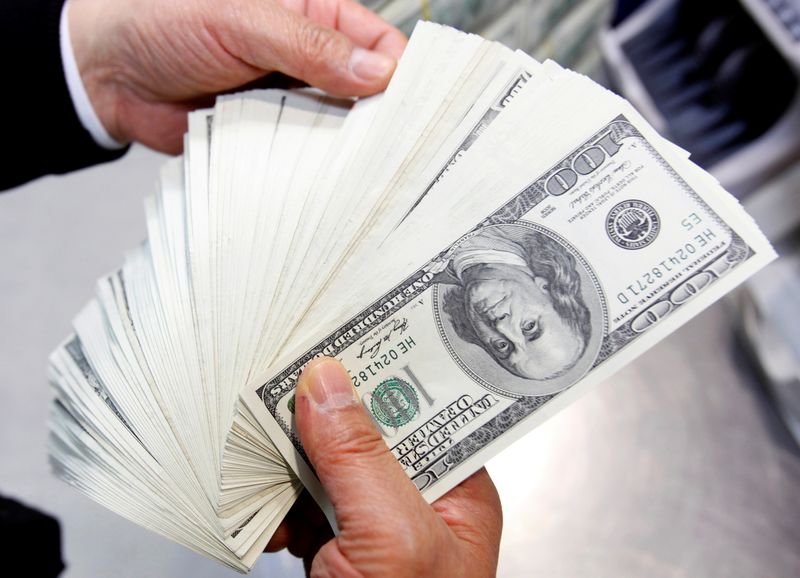Forex
Dollar rallies; Aussie, kiwi tumble after Chinese trade data


© Reuters. FILE PHOTO: An employee of the Korea Exchange Bank counts one hundred U.S. dollar notes during a photo opportunity at the bank’s headquarters in Seoul April 28, 2010. REUTERS/Jo Yong-Hak/File Photo
By Samuel Indyk and Rae Wee
LONDON (Reuters) – The U.S. dollar strengthened on Tuesday after another disappointing set of Chinese trade figures hurt the yuan, the and , while European risk-sensitive currencies also slid on a deteriorating demand outlook.
China’s imports and exports fell much faster than expected in July, data on Tuesday showed, with imports down 12.4% from a year earlier while exports contracted by 14.5%, in another sign of the country’s faltering economic recovery and subdued global demand.
The fell to a 2-1/2 week low of 7.2350 per dollar, while its onshore counterpart hit a more than two-week low of 7.2223 per dollar.
The Aussie weakened by as much as 1.1% to $0.6505, its lowest since June 1, while the kiwi slid to $0.6041, its lowest in two months.
“China’s imports data is another sign of weak domestic demand,” said Adam Cole, chief currency strategist at RBC Capital Markets.
“Australia is the main G10 proxy so it’s certainly not helping the Aussie,” Cole added.
While currency moves had been minimal in the early Asian day, the greenback extended its gains over the course of the European morning as risk sentiment turned fragile and Asian and European stocks failed to ride the previous day’s Wall Street rally.
The rose 0.5% to 102.59, lifting further away from Friday’s one-week low in the wake of a mixed U.S. jobs report which pointed to a cooling but still resilient labour market.
That added to hopes of a soft-landing scenario in the world’s largest economy, in the face of the Federal Reserve’s aggressive rate hikes.
“It’s become a wave of U.S. dollar buying, for sure,” said Sean Callow, a senior currency strategist at Westpac.
“Perhaps the market was just expecting that there would be a more upbeat tone to risk appetite today, given U.S. equities rallied.”
In Europe, sterling fell 0.5% to $1.2720, after a survey showed British retailers in July logged their slowest sales growth in 11 months.
The euro dropped 0.5% to $1.0953, while the risk-sensitive Swedish and Norwegian crowns both tumbled against the dollar.
“Both SEK and NOK have had some good sessions, when they were supported by positive risk sentiment, but are for the opposite reason slightly on the defensive,” said Jens Nærvig Pedersen, director at Danske Bank.
The U.S. dollar firmed 0.6% to stand at 143.23 yen.
Data on Tuesday showed that Japanese real wages fell for a 15th straight month in June on relentless price hikes, but nominal pay growth remained robust amid rising salaries for high-income workers and a broadening labour crunch.
“The BoJ will feel more comfortable in its message on the need for continued easing with real wages remaining weak,” said Colin Asher, senior economist at Mizuho.
All eyes are now on Thursday’s U.S. inflation data, where expectations are for core consumer prices in the United States to have risen 4.8% on an annual basis in July.
“The risk is quite symmetric going into the data,” RBC Capital Markets’ Cole said.
“You could see material market reaction to either an upside or downside surprise as the data are clearly pivotal for sentiment ahead of the September and October Federal Reserve meetings,” Cole added.

 Forex3 years ago
Forex3 years agoForex Today: the dollar is gaining strength amid gloomy sentiment at the start of the Fed’s week

 Forex3 years ago
Forex3 years agoUnbiased review of Pocket Option broker

 Forex3 years ago
Forex3 years agoDollar to pound sterling exchange rate today: Pound plummeted to its lowest since 1985

 Forex3 years ago
Forex3 years agoHow is the Australian dollar doing today?

 Cryptocurrency3 years ago
Cryptocurrency3 years agoWhat happened in the crypto market – current events today

 World3 years ago
World3 years agoWhy are modern video games an art form?

 Commodities3 years ago
Commodities3 years agoCopper continues to fall in price on expectations of lower demand in China

 Economy3 years ago
Economy3 years agoCrude oil tankers double in price due to EU anti-Russian sanctions























